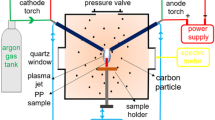The authors present the results of experiments on the synthesis of carbon nanostructures by the method of thermal chemical gas-phase deposition with the use of nickel nanopowders produced by the method of electric explosion of conductors and utilized as the catalysts. To study the process of origination and growth of individual carbon nanostructures, the authors conducted experiments not only on nanopowders, but also on separated clusters. Experiments were conducted at different temperatures (200–700°C) and pressures (100–400 mbar) to determine optimum conditions and the lower temperature boundary for carbon-nanostructure synthesis. The experiments have shown that the lower boundary of synthesis for nanopowders is a temperature of 325°C. For the separated powders, as for the nanopowders, stable growth of carbon nanostructures was observed at 350°C, but at pressures lower than 300 mbar. Unlike the carbon nanostructures produced on nanopowders, carbon nanostructures on separated powders exhibit a strong dependence of their origination and growth on temperature and pressure. Results of the Raman spectroscopy and of the x-ray structural analysis have shown that carbon nanostructures grown at 325°C and 300 mbar have the highest purity.
Similar content being viewed by others
References
A. Krueger, Carbon Materials and Nanotechnology, Wiley-VCH Verlag GmbH & Co. KGaA, Weinheim (2010).
J. H. Xia, X. Jiang, and C. J. Jia, The size effect of catalyst on the growth of helical carbon nanofibers, Appl. Phys. Lett., No. 95, 223110-1–223110-3 (2009).
W. Merchan-Merchan, A. V. Saveliev, L. Kennedy, and W. C. Jimenez, Combustion synthesis of carbon nanotubes and related nanostructures, Prog. Energy Combust. Sci., No. 36, 696–727 (2010).
Yu. S. Buranova, Physics, electronics, and nanotechnologies, Tr. MFTI, 3, No. 3, 30–40 (2011).
M. I. Lerner, N. V. Svarovskaya, S. G. Psakh′e, and O. V. Bakina, Production technology, characteristics, and certain fields of application of electric-explosion metal nanopowders, Ross. Nanotekhnol., 4, Nos. 11–12, 56–68 (2009).
Z. Ren, Y. Lan, and Y. Wang, Aligned Carbon Nanotubes. Physics, Concepts, Fabrication and Devices, Chapter 7, Springer-Verlag, Berlin–Heidelberg (2013), pp. 173–176.
S. Costa, E. Borowiak-Palen, M. Kruszyñska, A. Bachmatiuk, and R. J. Kaleńczuk, Characterization of carbon nanotubes by Raman spectroscopy, Mater. Sci. Poland, Vol. 26, No. 2, 433–441 (2008).
Author information
Authors and Affiliations
Corresponding author
Additional information
Translated from Inzhenerno-Fizizheskii Zhurnal, Vol. 88, No. 6, pp. 1403–1408, November–December, 2015.
Rights and permissions
About this article
Cite this article
Partizan, G., Mansurov, B.Z., Medyanova, B.S. et al. Synthesis of Carbon Nanostructures on Nickel Nanopowders Produced by the Method of Electric Explosion of Conductors. J Eng Phys Thermophy 88, 1451–1458 (2015). https://doi.org/10.1007/s10891-015-1329-9
Received:
Published:
Issue Date:
DOI: https://doi.org/10.1007/s10891-015-1329-9




